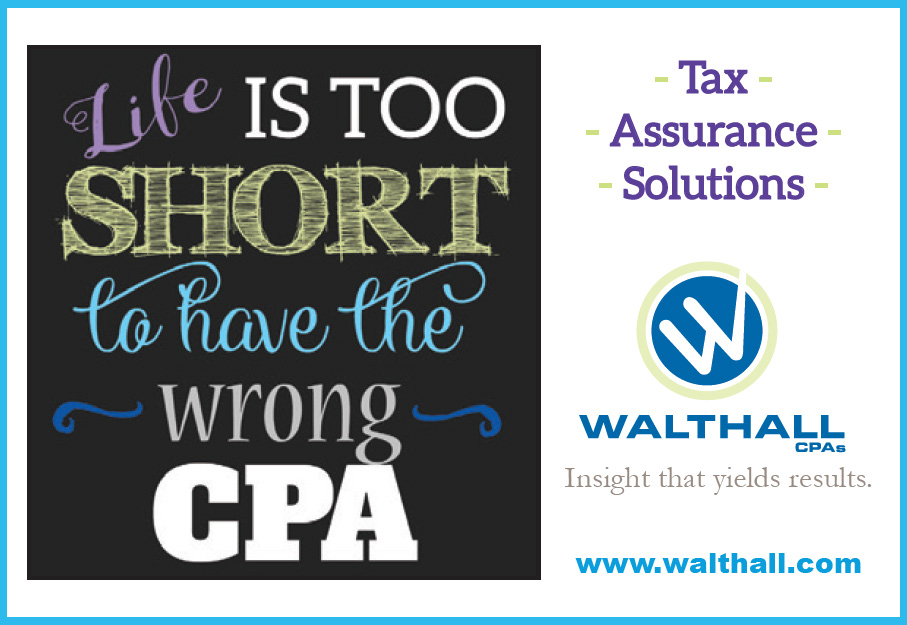By Bruce Bechhold, CPA, Walthall CPAs
There are many advantages to establishing an employer-sponsored retirement plan. Generally, employers are allowed deductions for contributions made. Employers need to include certain employees in the plan and give a portion of contributions to participating employees. It can be a tax-advantaged way to save for your own retirement, while providing employees with an appreciated benefit.
There are advantages and disadvantages to the many plans. Here is a brief overview of the more common plans and their 2017 requirements. By law, you might have to offer more than one plan in order to maximize contributions and benefits for higher-paid employees.
Profit-sharing plans allow employers to spread a contribution among the participants. You are not required to make an annual contribution in any given year, but they must be made on a regular basis. Employee contributions can’t exceed the lesser of 100% of their earnings for that year or $54,000. Employer deductible contributions cannot exceed 25% of the total compensation of the plan participants in that year.
Money purchase pension plans are similar to profit-sharing plans, but employers must make an annual contribution. Annual individual contributions are capped at 100% of earnings or $54,000. Employers can make deductible contributions up to 25% of the total compensation of all participants. These are relatively inexpensive plans to maintain though not popular due to the annual contribution requirement.
The 401(k) plan is popular and can be part of a profit-sharing plan. Participants fund the plan instead of just the employer by depositing a percentage of their salary into the plan. These plans can be expensive to administer, but the employer’s cost is generally small (they often match employee deferrals). The requirements are complicated, and several tests must be met for the plan to remain in force. Employees can designate all or part of their deferrals as after-tax Roth 401(k) contributions in which distributions of contributions and earnings are free from federal income tax.
There is no discrimination testing with a “safe harbor” 401(k) plan where employers either match employees’ contributions or make a fixed contribution for eligible employees, whether they contribute to the plan or not. Contributions are fully vested immediately.
Testing can also be avoided with a qualified automatic contribution arrangement. Under a QACA, employees who fail to make a deferral election are automatically enrolled. An employee’s contribution must be between 3% and 10% for the first two years of participation and then increase 1% each year until it reaches 6%. Employees can change their contribution rate or stop contributing at any time. Employers must make a contribution of either 3% of pay to each eligible employee or a matching contribution (dollar for dollar up to 1% of pay; 50% on contributions up to 6%). You can require two years of service before your contributions vest.
If it is only you (or you and your spouse), consider an “individual” 401(k). Without employees, there is no testing or ERISA requirements. You can make annual contributions of up to $18,000, plus $6,000 catch-up contributions if you are >50. You can also make profit-sharing contributions. Contributions can’t exceed $54,000 (plus catch-up).
SIMPLE 401(k) plans avoid discrimination testing and allow loans and Roth contributions. These are qualified plans and allow less deferrals than traditional 401(k)s.
A SIMPLE IRA plan is for companies with >100 employees and allows deferrals up to $12,500 annually. Employees age 50+ can make extra “catch-up” contributions of $3,000. Employers must match deferrals up to 3% of the contributor’s wages. These have no testing requirements and are inexpensive to maintain. Contributions are immediately vested, and the amount of contributions for highly paid employees is limited. Employers cannot maintain any other retirement plans.
Defined benefit programs are complex. A formula is set for participant distributions after retirement (a percentage of pay up to 100% of average pay at retirement), and an actuary certifies how much is required to fund those projected payments. Employers must contribute based on that determination. The maximum individual annual benefit is $215,000. There is no limit on the contributions, which are based on the projected benefits. These programs can offer the largest contribution deduction and the highest retirement benefits to business owners.
The rules regarding employer-sponsored retirement plans are difficult. If you are considering a retirement plan for your business, ask a professional to help you determine what works best for you and your business.
























